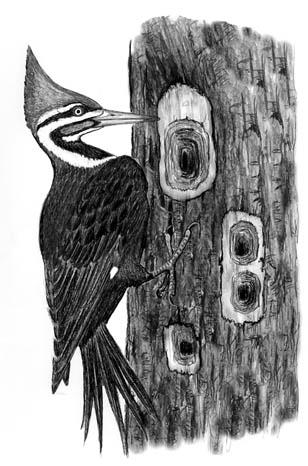
Dear Bird Folks,
My husband keeps trying to convince me that the huge woodpecker on our property is one of those very rare Ivory-billed Woodpeckers and not a Pileated Woodpecker. I think he’s crazy, but the two birds do look fairly similar in the book. Could you tell me the difference between the two birds? And while you are at it, please tell me a little about the habits of the Pileated Woodpecker. -Janice,
Cooperstown, NY
That’s familiar Janice,
Your last line, “and while you are at it,” reminds me of the phrase I hear a lot at my house, only here it’s “While you’re up…..” The people in my house would rather do without something than actually get it themselves. Here’s what I hear; “While you’re up, could you get me a napkin (a fair request at first, but then), and perhaps a glass of milk, plus a slice of pie, with a scoop of ice cream, vanilla. Oh, don’t forget to heat the pie.” Whether you are saying “while you are at it” or “while you are up,” either one means more work and less pie for me. But I don’t mind doing the extra work for you Janice. Just don’t ask for a napkin.
I’m a bit at a disadvantage trying to explain the differences between the two giant woodpeckers, because I’ve never seen an Ivory-billed Woodpecker. Very few people have actually seen one alive, except for one or two lucky researchers, and your crazy husband. This is just a guess, but I think a big difference between the two is that one bird has an “ivory bill”, but I may be way off on that one. The other thing to look for is the color of the back. When clinging to a tree trunk, woodpecker style, the ivory bill has lots of white on its back, while the pileated’s back is all black. Also the ivory bill’s chin is black, while the pileated’s chin is white, just like Santa.
It is highly unlikely that anyone reading this will ever see an Ivory-billed Woodpecker. But any of us, with a little effort, can find the fairly similar looking Pileated Woodpecker. The main reason is that the pileated is far more adaptive. It has been able to turn the misery created by human encroachment into an opportunity. Humans have driven the ivory-bill into a temporary extinction, while the pileated actually likes us and will sometimes come to our feeders and backyards.
One of the first signs that a pileated is in your area are the holes that they leave in trees. Most woodpeckers make cute round nest holes that look as though they were made with a cookie cutter. A pileated’s hole is anything but perfectly round. Their hole appears as if it were made by a blindfolded drunk, wielding a fire ax. When digging out insects from deep inside a tree, this woodpecker makes massive rectangle-shaped holes that make the tree look like it went through the battle of Gettysburg.
If you think that digging such large holes would cause significant damage to the trees, you would be right, of course it does. But the birds aren’t usually interested in healthy trees, they are more attracted to dead or dying trees which are filled with lovely wood-boring insects. Woodpeckers are constantly slamming their huge chisel-shaped bills against the sides of trees. When they find a spot that sounds hollow from insect damage, they start hacking their way in. When a Pileated Woodpecker decides it wants to get inside a tree, it is not delicate about it. The air around the tree is filled with hunks of flying bark, wood chips, and pieces of any unlucky squirrel that gets in the way.
If you have Pileated Woodpeckers on your property now, you will probably have them for a long time. Pileateds, may live ten years or more. They don’t migrate and usually spend most of their life in the same area. They only require large trees to keep them happy. That’s the major reason why Pileated Woodpeckers are not found in my area. Cape Cod’s original forests have been long cut down for firewood or to grow turnips. The pewny trees that we have now are not about to support this woodpecker.
A freakish problem that occasionally victimizes these woodpeckers is lightning. The large trees that the birds are attracted to also attract lightning bolts during summer storms. Many woodpeckers are lost when a storm hits and they don’t get out of the bathtub in time.
Your husband is not crazy Janice. But the only way that he is gong to see an Ivory-billed Woodpecker in Cooperstown is if one is elected into the Baseball Hall of Fame. That of course is silly, but the rare woodpecker still has a better chance of being elected to the Hall than Pete Rose does.